Fiber-Reinforced Lightweight Calcium Aluminate Cement-Based Concrete: Effect of Exposure to Elevated Temperatures
Abstract
1. Introduction
2. Materials and Methods
2.1. Materials
2.1.1. Aggregate and Filler
2.1.2. Cementing Materials
2.1.3. Superplasticizer
2.1.4. Fiber
2.2. Mix Proportions
Specimen Preparation and Test Methods
3. Test Results and Discussions
3.1. Flowability
3.2. Density
3.3. Compressive and Flexural Strength
3.4. Thermal Resistance
4. Conclusions
- The addition of pumice sand is found to increase the flowability of mixes when added up to 25% of the total coarse aggregate content. In larger quantities, however, it is found to reduce the overall flowability of concrete mixes. In terms of unit weight, however, a linear relationship can be made to show the reduction in unit weight as the pumice content increases.
- Based on the result of compressive and flexural strength tests, it is found that CEM mixes have a slower but steadier strength development rate. CAC specimens are found to perform better in terms of flexural strength but experience major flexural strength reduction over time due to the conversion process as a result of microstructural development.
- In high temperatures, surface spalling and cracking is found to take place in almost all the mixes, but CAC samples experience less overall disintegration compared to their CEM counterparts. In that respect, it is found that mixes that contain higher pumice aggregate content experience larger mass loss than the crushed stone-dominated mixes. The same results are also documented during the UPV tests; crushed stone-containing specimens experience less UPV speed reduction compared to their pumice-dominated counterparts. Yet, despite this, pumice-dominated CAC mixes outperform the CEM mixes in elevated temperatures, which shows the better suitability of utilizing lightweight aggregates with CACs.
- Observing samples after being exposed to elevated temperatures, it is found that CEM mixes experience a higher number of cracks and surface spalling. The same tendency is documented for pumice-dominated specimens compared to their 100% crushed stone-containing counterparts.
Author Contributions
Funding
Institutional Review Board Statement
Informed Consent Statement
Data Availability Statement
Acknowledgments
Conflicts of Interest
References
- Scrivener, K.L.; Cabiron, J.L.; Letourneux, R. High-performance concretes from calcium aluminate cements. Cem. Concr. Res. 1999, 29, 1215–1223. [Google Scholar] [CrossRef]
- Kim, H.; Son, H.M.; Lee, H.K. Review on recent advances in securing the long-term durability of calcium aluminate cement (cac)-based systems. Funct. Compos. Struct. 2021, 3, 035002. [Google Scholar] [CrossRef]
- Bentivegna, A.F. Multi-Scale Characterization, Implementation, and Monitoring of Calcium Aluminate Cement Based-Systems. Ph.D. Thesis, The University of Texas at Austin, Austin, TX, USA, 2012. [Google Scholar]
- Mangabhai, R.J. Calcium Aluminate Cements; CRC Press: Boca Raton, FL, USA, 1990. [Google Scholar] [CrossRef]
- Sereewatthanawut, I.; Prasittisopin, L. Effects of accelerating and retarding agents on nucleation and crystal growth of calcium aluminate cement. Open Ceram. 2022, 11, 100290. [Google Scholar] [CrossRef]
- Gosselin, C.; Gallucci, E.; Scrivener, K. Influence of self heating and Li2SO4 addition on the microstructural development of calcium aluminate cement. Cem. Concr. Res. 2010, 40, 1555–1570. [Google Scholar] [CrossRef]
- Zhang, Y.; Ye, G.; Gu, W.; Ding, D.; Chen, L.; Zhu, L. Conversion of calcium aluminate cement hydrates at 60 °C with and without water. J. Am. Ceram. Soc. 2018, 101, 2712–2717. [Google Scholar] [CrossRef]
- Pacewska, B.; Nowacka, M.; Wilińska, I.; Kubissa, W.; Antonovich, V. Studies on the influence of spent FCC catalyst on hydration of calcium aluminate cements at ambient temperature. J. Therm. Anal. Calorim. 2011, 105, 129–140. [Google Scholar] [CrossRef]
- Mostafa, N.Y.; Zaki, Z.I.; Abd Elkader, O.H. Chemical activation of calcium aluminate cement composites cured at elevated temperature. Cem. Concr. Compos. 2012, 34, 1187–1193. [Google Scholar] [CrossRef]
- Antonovič, V.; Keriene, J.; Boris, R.; Aleknevičius, M. The effect of temperature on the formation of the hydrated calcium aluminate cement structure. Procedia Eng. 2013, 57, 99–106. [Google Scholar] [CrossRef]
- Hidalgo, A.; Calvo, J.L.G.; Alonso, M.C.; Fernández, L.; Andrade, C. Microstructure development in mixes of calcium aluminate cement with silica fume or fly ash. J. Therm. Anal. Calorim. 2009, 96, 335–345. [Google Scholar] [CrossRef]
- López, A.H.; Calvo, J.L.G.; Olmo, J.G.; Petit, S.; Alonso, M.C. Microstructural evolution of calcium aluminate cements hydration with silica fume and fly ash additions by scanning electron microscopy, and mid and near-infrared spectroscopy. J. Am. Ceram. Soc. 2008, 91, 1258–1265. [Google Scholar] [CrossRef]
- Lee, N.K.; Koh, K.T.; Park, S.H.; Ryu, G.S. Microstructural investigation of calcium aluminate cement-based ultra-high performance concrete (UHPC) exposed to high temperatures. Cem. Concr. Res. 2017, 102, 109–118. [Google Scholar] [CrossRef]
- Hidalgo, A.; Petit, S.; Calvo, J.L.G.; Alonso, C.; Andrade, C. Microstructure of the system calcium aluminate cement-silica fume: Application in waste immobilization. Stud. Surf. Sci. Catal. 2007, 170, 1617–1628. [Google Scholar] [CrossRef]
- Akçaözoğlu, S. The effect of elevated temperature on the lightweight concrete containing waste PET aggregate. In Proceedings of the UBT International Conference, Durres, Albania, 28 October 2017; Volume 1, pp. 59–70. [Google Scholar] [CrossRef]
- Ukrainczyk, N.; Matusinović, T. Thermal properties of hydrating calcium aluminate cement pastes. Cem. Concr. Res. 2010, 40, 128–136. [Google Scholar] [CrossRef]
- Khaliq, W.; Khan, H.A. High temperature material properties of calcium aluminate cement concrete. Constr. Build. Mater. 2015, 94, 475–487. [Google Scholar] [CrossRef]
- Nodehi, M.; Nodehi, S.E. Ultra high performance concrete (UHPC): Reactive powder concrete, slurry infiltrated fiber concrete and superabsorbent polymer concrete. Innov. Infrastruct. Solut. 2022, 7, 39. [Google Scholar] [CrossRef]
- Nodehi, M.; Aguayo, F. Ultra high performance and high strength geopolymer concrete. J. Build. Pathol. Rehabil. 2021, 6, 34. [Google Scholar] [CrossRef]
- Hossain Anwar, K.M. Properties of volcanic pumice based cement and lightweight concrete. Cem. Concr. Res. 2004, 34, 283–291. [Google Scholar] [CrossRef]
- Nodehi, M. A comparative review on foam-based versus lightweight aggregate-based alkali-activated materials and geopolymer. Innov. Infrastruct. Solut. 2021, 6, 231. [Google Scholar] [CrossRef]
- Özkılıç, Y.O.; Aksoylu, C.; Arslan, M.H. Experimental and numerical investigations of steel fiber reinforced concrete dapped-end purlins. J. Build. Eng. 2021, 36, 102119. [Google Scholar] [CrossRef]
- Zeybek, Ö.; Özkılıç, Y.O.; Çelik, A.İ.; Deifalla, A.F.; Ahmad, M.; Sabri Sabri, M.M. Performance evaluation of fiber-reinforced concrete produced with steel fibers extracted from waste tire. Front. Mater. 2022, 9, 1057128. [Google Scholar] [CrossRef]
- ASTM C136-01; Standard Test Method for Sieve Analysis of Fine and Coarse Aggregates. ASTM International: West Conshohocken, PA, USA, 2001; Volume 4, pp. 1–5. [CrossRef]
- Topçu, I.B.; Uyguno, T. Properties of autoclaved lightweight aggregate concrete. Build. Environ. 2007, 42, 4108–4116. [Google Scholar] [CrossRef]
- ASTM A820; Standard Specification for Steel Fibers for Fiber-Reinforced Concrete. ASTM International: West Conshohocken, PA, USA, 2011; Volume 1, pp. 1–4. [CrossRef]
- ASTM C1116; Fiber-Reinforced Concrete (No. Reapproved 2015). ASTM International: West Conshohocken, PA, USA, 2015. [CrossRef]
- ASTM C127-15; Standard Test Method for Relative Density (Specific Gravity) and Absorption of Coarse Aggregate. Annual Book of ASTM Standards. ASTM International: West Conshohocken, PA, USA, 2015; pp. 1–5. [CrossRef]
- ASTM C138/C138M-13; Standard Test Method for Density (Unit Weight), Yield, and Air Content (Gravimetric). ASTM International: West Conshohocken, PA, USA, 2013; Volume 4, pp. 23–26. [CrossRef]
- ASTM C29/C29M-09; Standard Test Method for Bulk Density (‘Unit Weight’) and Voids in Aggregate. ASTM International: West Conshohocken, PA, USA, 2009; Volume 4, pp. 1–5. [CrossRef]
- ASTM C230; Standard Specification for Flow Table for Use in Tests of Hydraulic Cement 1. Annual Book of ASTM Standards. ASTM International: West Conshohocken, PA, USA, 2010; pp. 4–9. [CrossRef]
- ASTM C109/109M-16a; Standard Test Method for Compressive Strength of Hydraulic Cement Mortars (Using 2-in. or [50-mm] Cube Specimens). Annual Book of ASTM Standards. ASTM International: West Conshohocken, PA, USA, 2016; Volume 4, pp. 1–10. [CrossRef]
- ASTM C348; Standard Test Method for Flexural Strength of Hydraulic-Cement Mortars. Annual Book of ASTM Standards. ASTM International: West Conshohocken, PA, USA, 1998; Volume 4, pp. 2–7. [CrossRef]
- ASTM C 597-02; Pulse Velocity Through Concrete. ASTM International: West Conshohocken, PA, USA, 2003; Volume 4, pp. 3–6. [CrossRef]
- Karthika, V.; Awoyera, P.O.; Akinwumi, I.I.; Gobinath, R.; Gunasekaran, R.; Lokesh, N. Structural properties of lightweight self-compacting concrete made with pumice stone and mineral admixtures. Rev. Rom. Mater. /Rom. J. Mater. 2018, 48, 208–213. [Google Scholar]
- Güneyisi, E.; Gesoğlu, M.; Al-Rawi, S.; Mermerdaş, K. Effect of volcanic pumice powder on the fresh properties of self-compacting concretes with and without silica fume. Mater. Struct./Mater. Constr. 2014, 47, 1857–1865. [Google Scholar] [CrossRef]
- Shi, C.; Zou, X.; Wang, P. Influences of EVA and methylcellulose on mechanical properties of Portland cement-calcium aluminate cement-gypsum ternary repair mortar. Constr. Build. Mater. 2020, 241, 118035. [Google Scholar] [CrossRef]
- Hossain, K.M.A.; Lachemi, M. Mixture design, strength, durability, and fire resistance of lightweight pumice concrete. ACI Mater. J. 2007, 104, 449–457. [Google Scholar] [CrossRef]
- Pacewska, B.; Nowacka, M. Studies of conversion progress of calcium aluminate cement hydrates by thermal analysis method. J. Therm. Anal. Calorim. 2014, 117, 653–660. [Google Scholar] [CrossRef]
- Demirel, B.; Keleştemur, O. Effect of elevated temperature on the mechanical properties of concrete produced with finely ground pumice and silica fume. Fire Saf. J. 2010, 45, 385–391. [Google Scholar] [CrossRef]
- Sancak, E.; Darsun Sari, Y.; Simsek, O. Effects of elevated temperature on compressive strength and weight loss of the light-weight concrete with silica fume and superplasticizer. Cem. Concr. Compos. 2008, 30, 715–721. [Google Scholar] [CrossRef]
- Bingöl, A.F.; Gül, R. Effect of elevated temperatures and cooling regimes on normal strength concrete. Fire Mater. 2009, 33, 79–88. [Google Scholar] [CrossRef]
- Xu, W.; Dai, J.G.; Ding, Z.; Wang, Y. Polyphosphate-modified calcium aluminate cement under normal and elevated temperatures: Phase evolution, microstructure, and mechanical properties. Ceram. Int. 2017, 43, 15525–15536. [Google Scholar] [CrossRef]
- Kore Sudarshan, D.; Vyas, A.K. Impact of fire on mechanical properties of concrete containing marble waste. J. King Saud Univ. -Eng. Sci. 2019, 31, 42–51. [Google Scholar] [CrossRef]
- Tai, Y.S.; Pan, H.H.; Kung, Y.N. Mechanical properties of steel fiber reinforced reactive powder concrete following exposure to high temperature reaching 800 °C. Nucl. Eng. Des. 2011, 241, 2416–2424. [Google Scholar] [CrossRef]

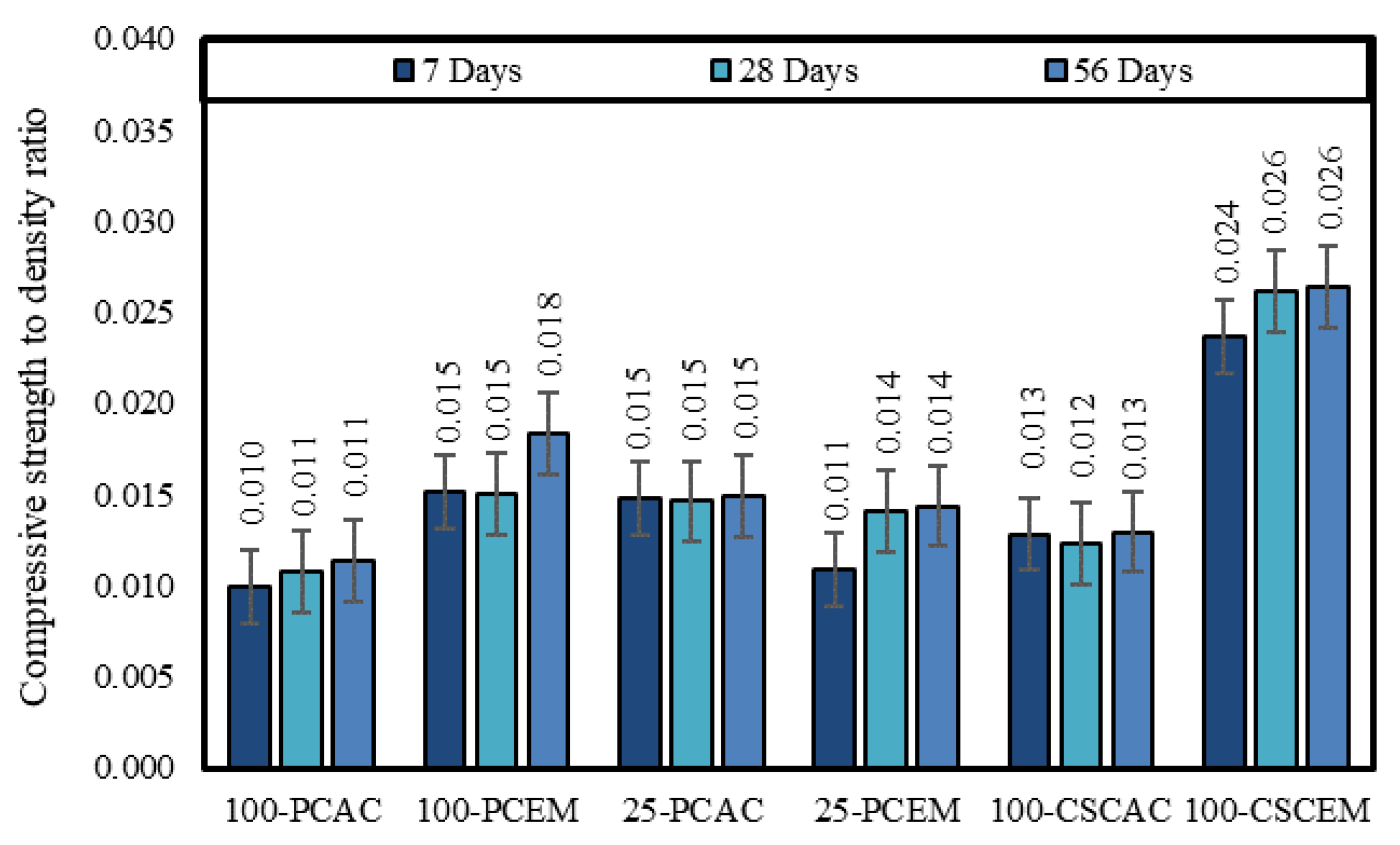

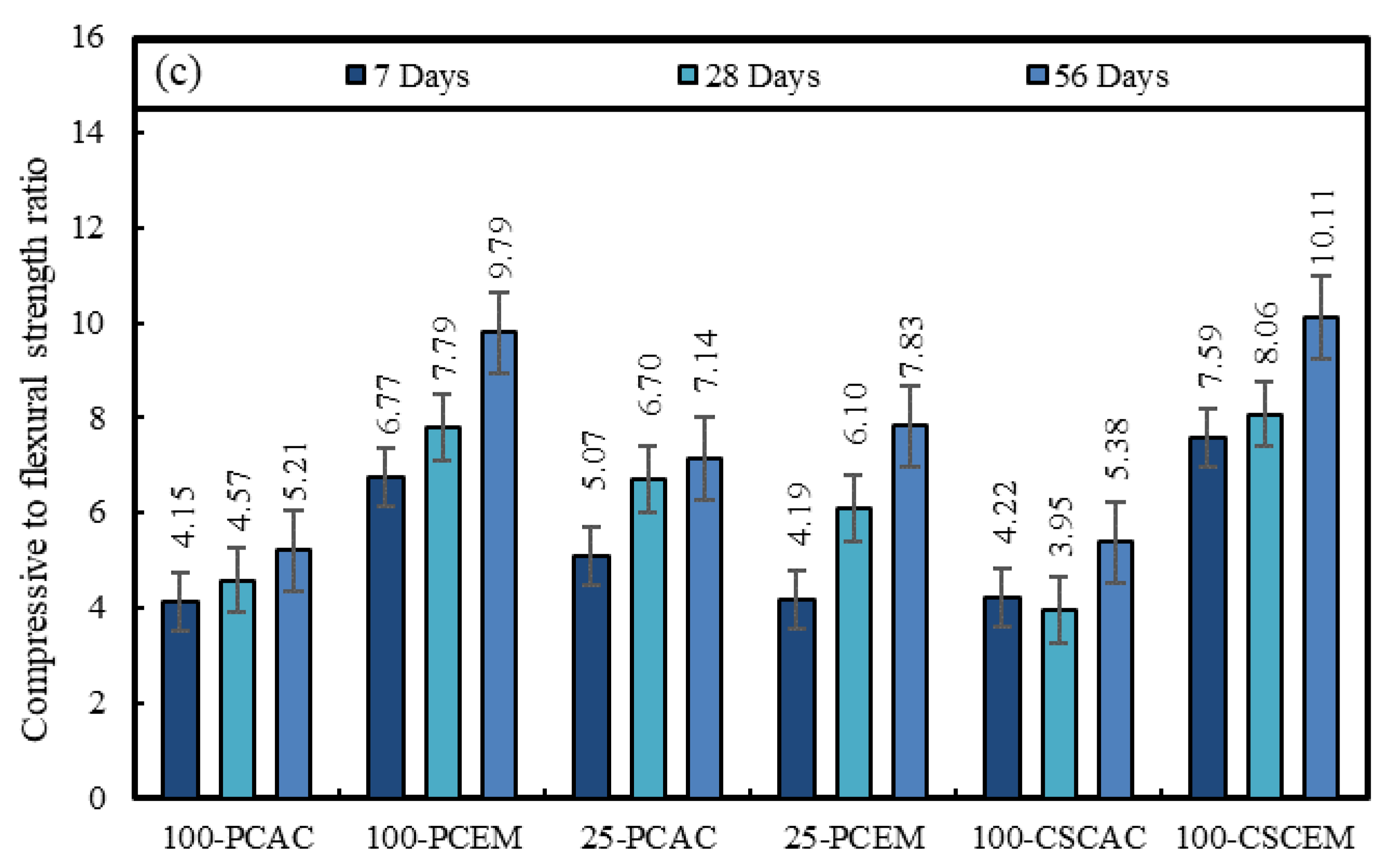
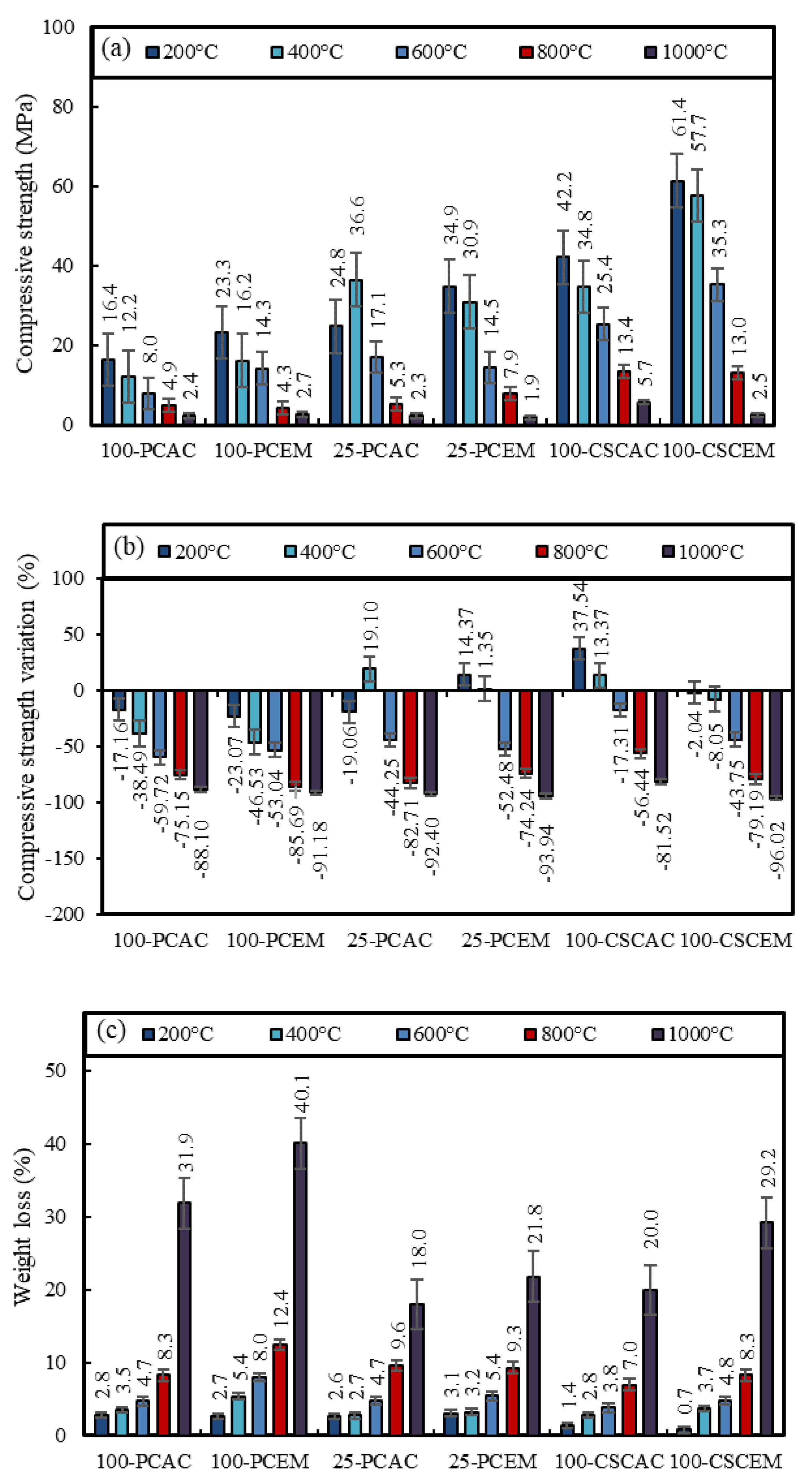


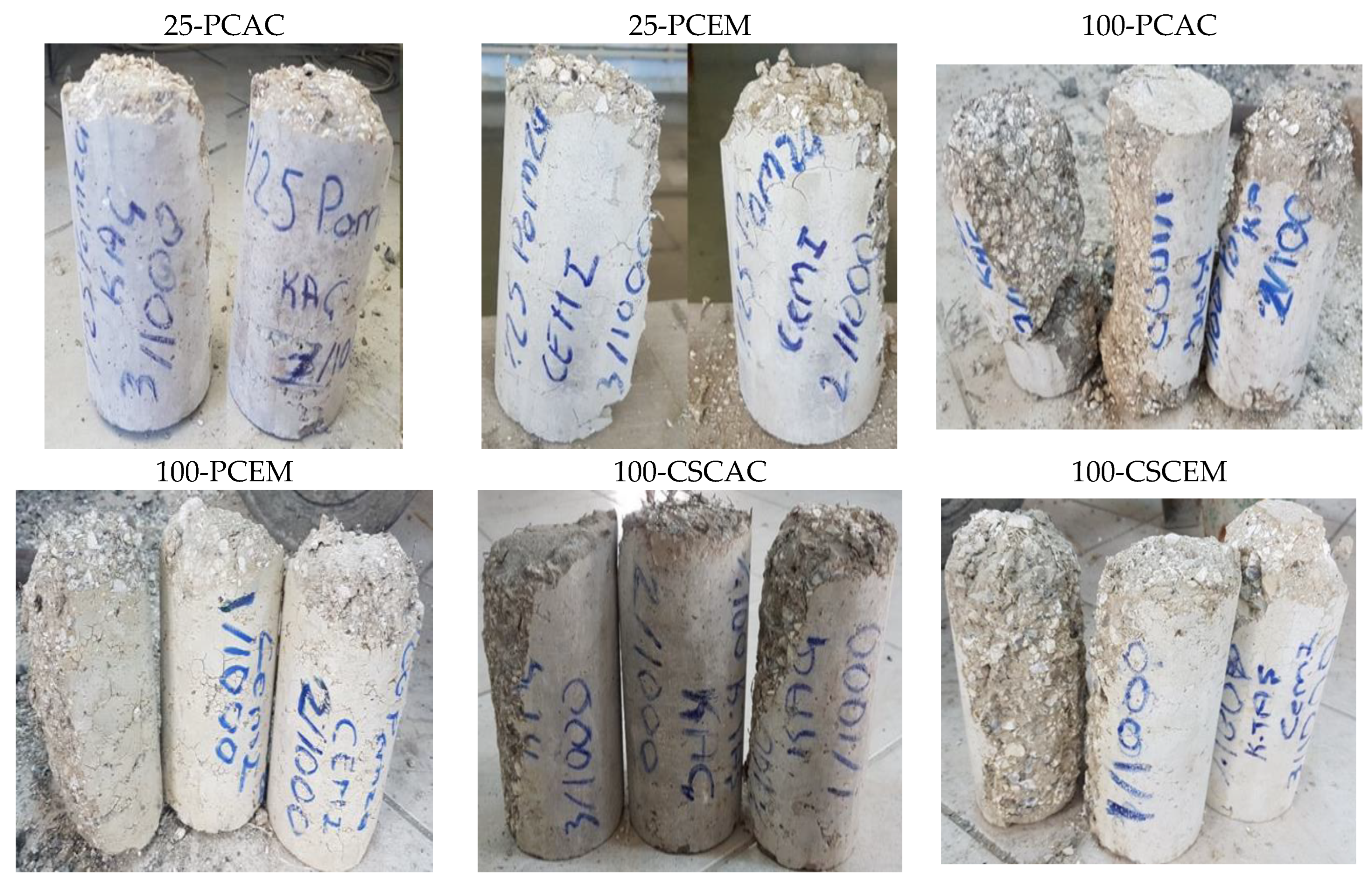
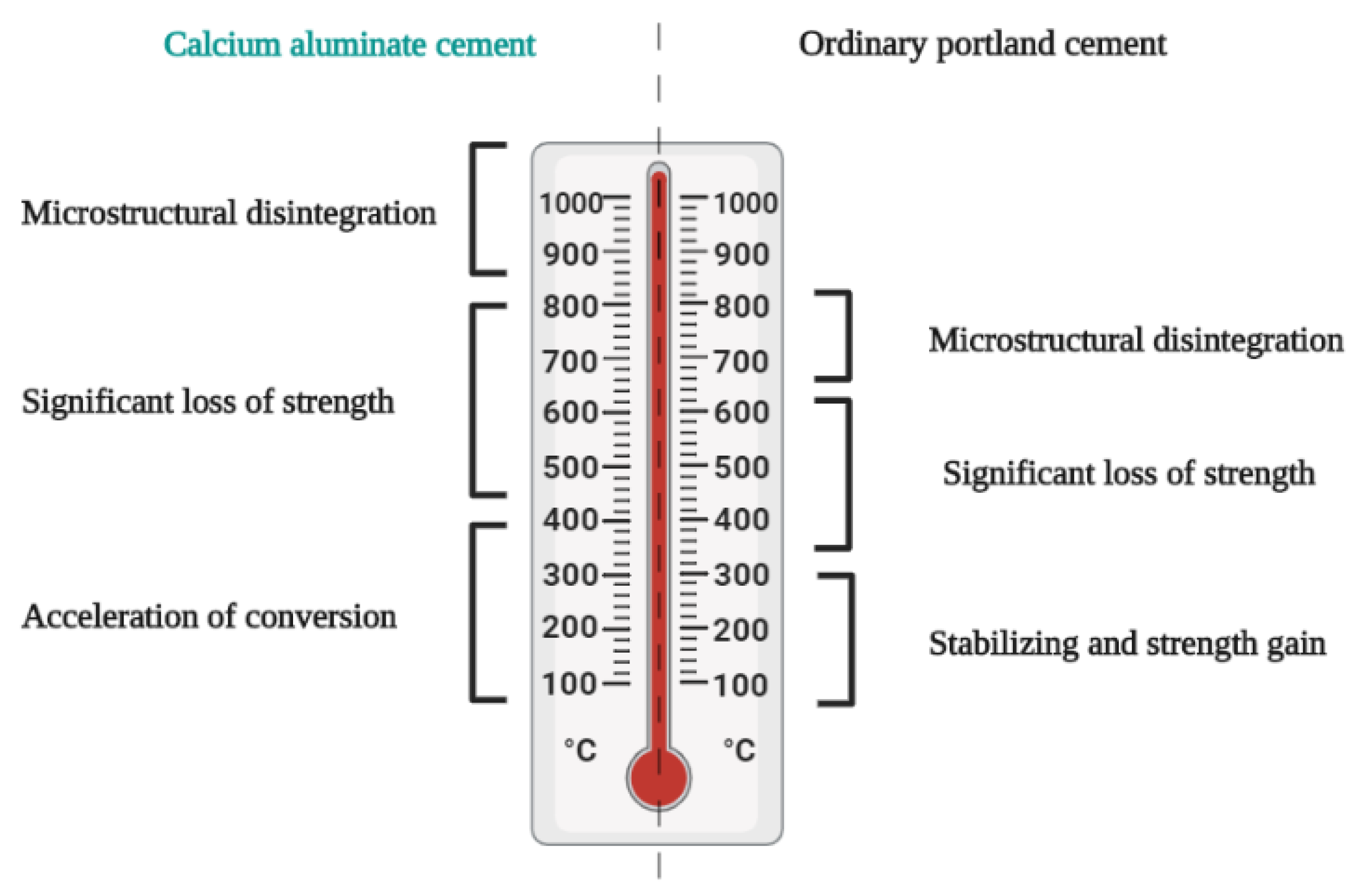
| Hydrates | Chemical Composition (%) | Structure Shape | Density (g/cm3) | ||
|---|---|---|---|---|---|
| CaO | Al2O3 | H2O | |||
| CAH10 | 16.6 | 30.1 | 53.3 | Hexagonal | 1.743 |
| C2AH8 | 31.3 | 28.4 | 40.3 | Hexagonal | 1.950 |
| C3AH6 | 44.4 | 27.0 | 28.6 | Cubic | 2.527 |
| AH3 | - | 65.4 | 34.8 | Hexagonal | 2.420 |
| Composition | Content (%) |
|---|---|
| SiO2 | 74.10 |
| Al2O3 | 13.45 |
| Fe2O3 | 1.40 |
| CaO | 1.17 |
| MgO | 0.35 |
| K2O | 4.10 |
| Na2O | 3.70 |
| SO3 | 0.12 |
| Loss on ignition | 1.54 |
| Aggregates (Size Range in mm) | Water Absorption (%) | Specific Gravity (g/cm3) |
|---|---|---|
| Crushed stone (8–16 mm) | 0.04 | 2.71 |
| Crushed stone (4–8 mm) | 0.04 | 2.71 |
| Pumice (8–16 mm) | 31.3 | 0.96 |
| Pumice (4–8 mm) | 28.5 | 1.05 |
| Natural sand (0–4 mm) | 1.5 | 2.63 |
| Crushed sand | 1.2 | 2.69 |
| Component (%) | CEM I 42.5R | CAC | Silica Fume |
|---|---|---|---|
| CaO | 63.92 | 36.20 | 0.96 |
| SiO2 | 19.55 | 3.60 | 87.61 |
| Al2O3 | 5.12 | 39.80 | 1.48 |
| Fe2O3 | 2.52 | 17.05 | 2.17 |
| MgO | 1.02 | 0.65 | 1.32 |
| SO3 | 2.96 | 0.04 | 1.95 |
| Na2O | 0.27 | 0.16 | – |
| K2O | 0.67 | 0.11 | – |
| Cl− | 0.0089 | 0.009 | – |
| Loss on ignition | 4.08 | 0.30 | 3.85 |
| Res. solution | 0.36 | 0.22 | – |
| Specific gravity | – | – | 2.3 |
| Type of Superplasticizer | Polycarboxylic Ether Based |
|---|---|
| Color | Amber |
| Density | 1.069–1.109 kg/L |
| Chlorine content | <0.1 |
| Alkaline content | <3 |
| Fiber Type | Length L (mm) | Diameter d (mm) | L/d Ratio | Tensile Strength (N/mm2) |
|---|---|---|---|---|
| Dramix RC 50/35 BN | 35 | 0.70 | 50 | 1400 |
| Mix ID | Information on Mix ID |
|---|---|
| 25-PCAC | CAC mixture with 25% pumice aggregate |
| 25-PCEM | CEM-I 42.5 with 25% pumice |
| 100-PCAC | CAC with 100% pumice |
| 100-PCEM | CEM-I 42.5 with 100% pumice |
| 100-CSCAC | CAC with 100% crushed stone |
| 100-CSCEM | CEM-I 42.5 with 100% crushed stone |
| Mix ID | CEM I 42.5 (kg/m3) | CAC (kg/m3) | Silica Fume (kg/m3) | Pumice 8–16 mm (kg/m3) | Pumice 4–8 mm (kg/m3) | Crushed Stone Filler (kg/m3) | Crushed Stone 8–16 mm (kg/m3) | Crushed Stone 4–8 mm (kg/m3) | Natural Sand 0–4 mm (kg/m3) | Water | Steel Fiber (kg/m3) | Polypropylene Fiber (kg/m3) | Superplasticizer (kg/m3) |
|---|---|---|---|---|---|---|---|---|---|---|---|---|---|
| 100-PCAC | - | 500 | 52 | 154 | 168 | 466 | - | - | 338 | 180 | 25 | 0.75 | 10 |
| 100-PCEM | 500 | - | 52 | 154 | 168 | 466 | - | - | 338 | 180 | 25 | 0.75 | 10 |
| 25-PCAC | - | 500 | 52 | 154 | 168 | 466 | - | 435 | 338 | 180 | 25 | 0.75 | 10 |
| 25-PCEM | 500 | - | 52 | 154 | 168 | 466 | - | 435 | 338 | 180 | 25 | 0.75 | 10 |
| 100-CCAC | - | 500 | 52 | - | - | 470 | 438 | 438 | 340 | 180 | 25 | 0.75 | 10 |
| 100-CCEM | 500 | - | 52 | - | - | - | 438 | 438 | - | 180 | 25 | 0.75 | 10 |
| Specimens | Flowability (mm) |
|---|---|
| 100-PCAC | 500 |
| 100-PCEM | 550 |
| 25-PCAC | 700 |
| 25-PCEM | 750 |
| 100-CSCAC | 600 |
| 100-CSCEM | 650 |
| Specimens | Dry Bulk Density (kg/m3) | Unit Weight (kg/m3) |
|---|---|---|
| 100-PCAC | 1745 | 1752 |
| 100-PCEM | 1656 | 1826 |
| 25-PCAC | 2060 | 2128 |
| 25-PCEM | 2123 | 2202 |
| 100-CSCAC | 2368 | 2430 |
| 100-CSCEM | 2376 | 2456 |
| Specimen ID | 200 °C | 400 °C | 600 °C | 800 °C | 1000 °C | |||||
|---|---|---|---|---|---|---|---|---|---|---|
| Before | After | Before | After | Before | After | Before | After | Before | After | |
| 100-PCAC | 3.83 | 3.45 | 4.11 | 2.93 | 3.83 | 1.56 | 3.39 | 0.18 | 3.9 | 0.15 |
| 100-PCEM | 4.03 | 3.82 | 3.86 | 2.12 | 3.96 | 1.49 | 4.16 | 0.38 | 4.11 | 0.14 |
| 25-PCAC | 4.59 | 4.24 | 3.57 | 3.74 | 3.96 | 0.91 | 4.27 | 0.62 | 4.56 | 0.73 |
| 25 PCEM | 4.82 | 3.96 | 3.97 | 3.76 | 3.81 | 0.82 | 3.67 | 0.38 | 4.95 | 0.39 |
| 100-CSCAC | 4.67 | 4.41 | 3.98 | 2.95 | 3.81 | 2.42 | 5.23 | 0.74 | 3.52 | 0.71 |
| 100-CSCEM | 4.45 | 4.56 | 5.12 | 3.79 | 4.6 | 2.82 | 4.65 | 0.54 | 4.14 | 0.34 |
Disclaimer/Publisher’s Note: The statements, opinions and data contained in all publications are solely those of the individual author(s) and contributor(s) and not of MDPI and/or the editor(s). MDPI and/or the editor(s) disclaim responsibility for any injury to people or property resulting from any ideas, methods, instructions or products referred to in the content. |
© 2023 by the authors. Licensee MDPI, Basel, Switzerland. This article is an open access article distributed under the terms and conditions of the Creative Commons Attribution (CC BY) license (https://creativecommons.org/licenses/by/4.0/).
Share and Cite
Salli Bideci, Ö.; Yılmaz, H.; Gencel, O.; Bideci, A.; Çomak, B.; Nodehi, M.; Ozbakkaloglu, T. Fiber-Reinforced Lightweight Calcium Aluminate Cement-Based Concrete: Effect of Exposure to Elevated Temperatures. Sustainability 2023, 15, 4722. https://doi.org/10.3390/su15064722
Salli Bideci Ö, Yılmaz H, Gencel O, Bideci A, Çomak B, Nodehi M, Ozbakkaloglu T. Fiber-Reinforced Lightweight Calcium Aluminate Cement-Based Concrete: Effect of Exposure to Elevated Temperatures. Sustainability. 2023; 15(6):4722. https://doi.org/10.3390/su15064722
Chicago/Turabian StyleSalli Bideci, Özlem, Hakan Yılmaz, Osman Gencel, Alper Bideci, Bekir Çomak, Mehrab Nodehi, and Togay Ozbakkaloglu. 2023. "Fiber-Reinforced Lightweight Calcium Aluminate Cement-Based Concrete: Effect of Exposure to Elevated Temperatures" Sustainability 15, no. 6: 4722. https://doi.org/10.3390/su15064722
APA StyleSalli Bideci, Ö., Yılmaz, H., Gencel, O., Bideci, A., Çomak, B., Nodehi, M., & Ozbakkaloglu, T. (2023). Fiber-Reinforced Lightweight Calcium Aluminate Cement-Based Concrete: Effect of Exposure to Elevated Temperatures. Sustainability, 15(6), 4722. https://doi.org/10.3390/su15064722











